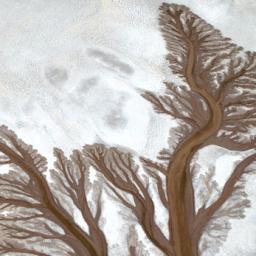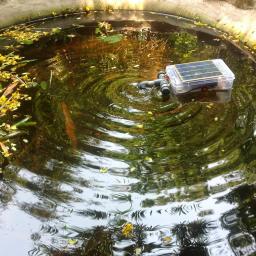
The Colorado River Delta is typically a vast expanse of cracked, dry earth. The Colorado River itself comes to its end at the Morelos Dam on the US-Mexico border, and its outflow has been managed (poorly) by both nations ever since the dam was built. That means the river has been providing lots of drinking water and water for irrigated agriculture, but not much for any other reason.
That has suddenly changed, as both nations agreed to permit a flow of 1% of the water to be released for purposes of restoring parts of the ecosystem. From the article:
"We were able to persuade decision-makers in both countries that it was really time to turn the corner in the relationship and really try something different," [Environmental Defense Fund representative Jennifer] Pitt said. "That instead of unilateral actions on either side of the border with no particular concern for impacts on the other side of the border it would be better to have a collaborative approach." In 2012, the Mexican and American governments signed Minute 319, and the pulse flow was one of the provisions it contained. ... "During the months of late March and April, with the snow melt in the upper basin, a lot of water will come in a short period of time," he said. "So the pulse flow is mimicking that on a smaller scale." During the eight-week project, which ended on Sunday, just less than 1 percent of the river's annual average flow was released into the delta. Teams of scientists from environmental groups and universities have been closely monitoring the impact that the restored flow has had on this desiccated region.
[Ed. note: Glad to have some good environmental news for a change.]

Almost everyone has dealt with those annoying little
buggers that like to bite and suck your blood during the summer months. In less fortunate parts of the world the situation is much more serious with the dangers of blood borne pathogens such as malaria. The mainstay has been to distribute and use mosquito
nets .
After seeing earlier in the week what some people are trying to do with solar power and roadways, I ran across this cost effective
device which helps stop the spread at the source and save lives.
Four new
ozone-killing gases have been found in the atmosphere. The new gases found, three chlorofluorocarbons (CFC) and one hydro-chlorofluorocarbon (HCFC), seem to be man-made since they where not around until the 1960s.
Lead researcher Dr Johannes Laube from UEA's School of Environmental Sciences said: "Our research has shown four gases that were not around in the atmosphere at all until the 1960s which suggests they are man-made."
"CFCs are the main cause of the hole in the ozone layer over Antarctica. Laws to reduce and phase out CFCs came into force in 1989, followed by a total ban in 2010. This has resulted in successfully reducing the production of many of these compounds on a global scale. However, legislation loopholes still allow some usage for exempted purposes."
"The identification of these four new gases is very worrying as they will contribute to the destruction of the ozone layer. We don't know where the new gases are being emitted from and this should be investigated. Possible sources include feedstock chemicals for insecticide production and solvents for cleaning electronic components."
"What's more, the three CFCs are being destroyed very slowly in the atmosphere - so even if emissions were to stop immediately, they will still be around for many decades to come," he added.
 Reuters has an interesting article about the new partnership between FTSI (formally Frac Tech) and Sinopec to bring technological practices from the American shale gas revolution to China, where the potential for shale gas exploration and fraccing technology is significant. The article states that no-one knows where and when the next major unconventional hydrocarbon play will be found, but that Sinopec has already been looking in the Sichuan Basin. Were China to find a significant gas resource, it might help them to reduce their reliance on coal which has recently been estimated to cause a 5.5 year reduction in life expectancy .
Reuters has an interesting article about the new partnership between FTSI (formally Frac Tech) and Sinopec to bring technological practices from the American shale gas revolution to China, where the potential for shale gas exploration and fraccing technology is significant. The article states that no-one knows where and when the next major unconventional hydrocarbon play will be found, but that Sinopec has already been looking in the Sichuan Basin. Were China to find a significant gas resource, it might help them to reduce their reliance on coal which has recently been estimated to cause a 5.5 year reduction in life expectancy .

